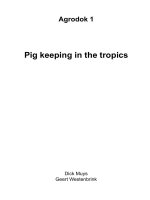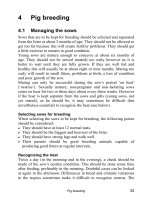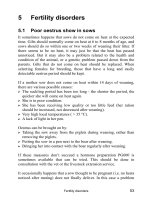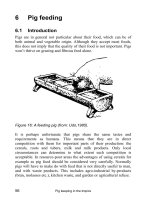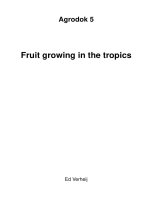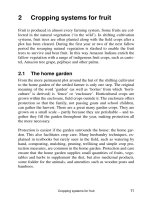Fruit growing in the tropics - Part 1 potx
Bạn đang xem bản rút gọn của tài liệu. Xem và tải ngay bản đầy đủ của tài liệu tại đây (25.25 KB, 10 trang )
Agrodok 5
Fruit growing in the tropics
Ed Verheij
This publication is sponsored by: ICCO
© Agromisa Foundation and CTA, Wageningen, 2006.
A
ll rights reserved. No part of this book may be reproduced in any form, by print, photocopy,
microfilm or any other means, without written permission from the publisher.
First edition: 1992
Third, completely revised, edition: 2006
A
uthor: Ed Verheij
Illustrator: Barbera Oranje
Design: Eva Kok
Printed by: Digigrafi, Wageningen, the Netherlands
Language editor: Ninette de Zylva
ISBN Agromisa: 90-8573-056-2
ISBN CTA: 978-92-9081-344-6
Foreword
3
Foreword
The previous editions of this Agrodok, published in 1992 and 1999,
gave a general introduction into fruit growing in the tropics and de-
scribed 8 major crops. Working on this revision, the general introduc-
tion quickly filled the entire Agrodok! And if the major fruit crops are
to be dealt with anew, each crop will no doubt require an Agrodok of
its own. In fact it may be better to publish regional crop manuals,
rather than trying to cram information for various parts of the tropics
into a single booklet.
The aim of this revised text is to foster your interest in and under-
standing of fruit growing. Traditional knowledge has been combined
with insights gained through research work. No recipes are given for
growing specific fruit crops. The contents are directed at home gar-
deners, growers who depend for (part of) their income on the sale of
fruit, extension workers and others who support gardeners and grow-
ers.
Acknowledgement
I am greatly indebted to Chris Menzel, Horticulturist at the Queen-
sland Department of Primary Industries, Australia, who reviewed the
manuscript and made welcome editorial suggestions. His comments
made me reconsider what can be done to improve flowering, leading
to a revision of this key issue. Johannes van Leeuwen of the National
Research Institute of the Amazon (INPA) in Manaus, Brazil and
Bennie Bloemberg, who devoted some 30 years to development work
in East Africa, proposed improvements of the manuscript and gathered
much-appreciated information. I gratefully acknowledge the help of
Janhein Loedeman in reshuffling and shortening text in the final
stages.
Wageningen, August 2006
Ed Verheij
Fruit growing in the tropics
4
Contents
1 Introduction 6
1.1 No flowers, no fruit 6
1.2 Importance of trees and fruits 7
1.3 Reasons NOT to grow fruit 9
2 Cropping systems for fruit 11
2.1 The home garden 11
2.2 Orchards and plantations 12
2.3 Small is beautiful 13
2.4 Summary 14
3 Form and function 15
3.1 Single-stemmed and branched fruit crops 15
3.2 A closer look at single-stemmed fruit crops 19
3.3 Form and function of branched fruit trees 22
3.4 Summary 34
4 Propagation 35
4.1 Seedlings or clonal plants? 35
4.2 Outline of cloning methods 37
4.3 Concluding remarks 40
5 Training: pruning and bending 41
5.1 Definition; the limited role of pruning in tropical fruits 41
5.2 Cutting increasingly large portions of a shoot/branch 42
5.3 Summary 46
6 Control over the growth rhythm 47
6.1 Increasing stress for better flowering 47
6.2 Fitting crop care operations in the growth cycle 50
6.3 Forcing synchronous flushing/flowering 52
Contents
5
7 Pollination and fruit set 55
7.1 Flowering habit 55
7.2 Pollination 56
8 Crop protection 59
8.1 Limiting use of pesticides 60
9 Harvesting 64
9.1 Mature or ripe fruit? 64
9.2 Harvest methods, harvest indices 65
9.3 Handling and marketing 68
10 Layout and establishment of the orchard 69
10.1 Tree spacing 69
10.2 Orchard establishment 71
Appendix: Horticultural traits 74
Further reading 78
Useful addresses 80
Glossary 82
Index 87
Fruit growing in the tropics
6
1 Introduction
1.1 No flowers, no fruit
So you are interested in growing fruit! Perhaps you already grow fruit
in a home garden or in an orchard, or you intend to do so. This Agro-
dok is written to make you feel at home amidst the different fruits
crops you see around you. More than 60 fruits are mentioned in the
text. The Index at the end lists the botanical names and the pages on
which you can find more information about these fruits. There is also
an Appendix with particulars about the flowers (in connection with
pollination), the fruit, the seed and the common methods of propaga-
tion.
No flowers, no fruits! Scanty flowering is the main reason for disap-
pointing crops in the tropics. Hence the flowering habit of a fruit crop
is extremely important. Flowering habit is linked with tree habit, as
explained in Chapter 3. A few very common fruit crops – pineapple,
banana, papaya, (also palms) – have the growth habit of a single large
shoot. These fruits as a rule flower and fruit well if they grow well. So
they respond to the common measures to stimulate growth – watering,
manuring, crop protection – that every farmer knows about. But the
large majority of the fruit crops branch freely issuing hundreds or
thousands of shoots. Each of these trees branches in its own typical
way. These freely branching trees get the most attention in this Agro-
dok, because they are the problem crops that often flower poorly.
The main reason for scanty flowering is simple: the tree ‘forgets’ to
form floral buds because it is too busy making new shoots. In fact
most branched fruit crops require a period of stress – in the form of a
cold or dry season – to put a stop to shoot growth in favour of laying
down floral buds. And if the natural stress is inadequate – as is the
case in large parts of the tropics for many fruit crops in most years,
you will need to check shoot growth yourself. In such tree crops,
therefore, measures to limit shoot growth and measures to stimulate
growth should be alternated according to the seasons. Thus the grower
Introduction
7
of these fruits needs special skills and has to apply them at the right
time. The aim is to achieve a better BALANCE between vegetative
growth and reproductive growth (the course of events from the initia-
tion of floral buds to ripening of the fruit). This is the subject of Chap-
ter 6.
Pruning, discussed in Chapter 5, is one of the skills employed in
branching trees. But in the tropics the results of pruning are all too
often negative. The main reason is that pruning leads to compensatory
regrowth, which sets back the formation of floral buds. Thus pruning
is important mainly when trees flower and fruit abundantly, so that
shoot growth needs to be stimulated rather than flowering,
Without flowers no fruit. But also: without pollination no fruit set!
There are exceptions to this rule, but flowers generally need to be pol-
linated, preferably by cross-pollination, to set fruit. Fruit crops differ
greatly in the types of flowers they bear and in the way pollination and
fruit set is effected. This important subject is dealt with in Chapter 7.
1.2 Importance of trees and fruits
Big trees and small trees
Trees are the natural vegetation in large parts of the tropics, in particu-
lar, in humid regions. The importance of trees stems partly from their
large size and perennial character. Trees shape the landscape and
frame buildings; they cast their shade over man and beast. They pro-
tect the soil against the hot sun, heavy rain and strong winds, espe-
cially during seasons when there are no annual crops in the fields. The
roots explore deep soil layers, recycling water and nutrients that can-
not be reached by the roots of field crops. In these ways, trees amelio-
rate their immediate environment.
There is increasing evidence that trees protect and exploit the envi-
ronment more effectively than annuals. Evergreen trees have the ad-
vantage over seasonal crop plants in that the canopy of leaves is pre-
sent throughout the year. Agrodok 16: Agroforestry, explains the role
Fruit growing in the tropics
8
of trees in more detail, both in the environment and in the farming sys-
tem.
As a fruit grower you harvest fruit, not leaves and wood. Unfortu-
nately, the so-called ‘harvest index’ – that is the share of fruit in the
total amount of organic matter produced – is often quite low, espe-
cially for most freely branching fruit trees. The tomatoes, eggplants,
cucurbits, etc. of the vegetable grower may not exploit the environ-
ment nearly as well as the tree fruits, but they yield many more tons of
fruit per ha than most trees. Perhaps you should grow vegetables
People think it natural that trees grow to a large size, but in fact trees
grow big because poor flowering and fruiting leave enough energy for
ever more shoots to grow. As a fruit grower your aim should be to
produce fruit with a minimum of wood! If you could make a tree bear
a full crop – in relation to its size – each year, starting within a few
years from planting, it would never grow big. Imagine a mature
mango tree the size of a coffee bush: think of the ease of pruning, crop
protection, selective harvesting For the fruit grower SMALL IS
BEAUTIFUL. This is the conclusion of Chapter 2, in which the differ-
ent cropping systems for fruit are compared.
Cloning is the first step towards control over tree size, as explained in
Chapter 4: Propagation. In Chapter 9, Harvesting, it is argued that
large tree size and top quality fruit do not go together: harvesting each
fruit when it is at its best is impossible and avoiding blemishes is dif-
ficult.
Who eats fruit and why?
In Africa fruit is often considered as ‘food for the birds’ (Swa-
hili:”chakula cha ndege”) and it is left to children to compete with the
birds; a man – it is said – should drink beer. In Central and South
America, people are usually more fruitminded. Asians generally have
a great appreciation of fruits.
Introduction
9
The regard for fruit appears to be related to the propagation methods.
Until recently fruit trees in Africa were commonly raised from seed;
hence there were no named varieties or cultivars (banana being an im-
portant exception). Asia, on the other hand, is the area of origin of
several important cloning methods, enabling growers to propagate su-
perior varieties. Appreciation of the distinct taste of each variety de-
veloped through the ages. Home gardens flourish, people are familiar
with home preservation and cooking methods, and aware of the health
benefits traditionally attributed to each fruit. But for all that most peo-
ple in Asia must make do with far less fruit than they would like to
eat.
1.3 Reasons NOT to grow fruit
This booklet is meant to put across new ideas to gardeners, growers
and extension workers. The intention, of course, is to encourage you
to grow fruit. Nevertheless it is only fair to briefly list reasons not to
grow fruit as well, even though you have probably thought of these
reasons yourself.
No doubt you took into account that it takes years before you can har-
vest the first crop. And when the trees come into bearing they may fail
to flower, or to set fruit, or that the fruit may drop prematurely. But,
supposing the trees are doing fine: have you considered the risk of fire
scorching your trees? And what about pilferage, birds, bats and rats
eating the fruit, not to say anything about losses due to other pests and
diseases?
The fruit grower faces a lot of uncertainty in producing a crop and, if
there is a good crop to be picked, there is still the uncertainty of the
market. There is truth in the saying that producing a fruit crop is the
lesser half of the problem, post-harvest handling and marketing repre-
senting the larger half
Hopefully you have given proper thought to all these risks, problems
and possible setbacks, because this Agrodok cannot do it for you! For
Fruit growing in the tropics
10
one thing, the contents are limited to fruit production. Some aspects,
such as out-of-season production, are related to marketing, but mar-
keting as such is not dealt with. Local markets and customary ar-
rangements with middlemen vary so much and the market situation
changes so rapidly when the production of a new fruit increases, that
marketing advice should be based on local conditions.
In Chapter 8 the principles of controlling pests and diseases are dis-
cussed with some examples. Finally, if you have considered all the
above objections and still are about to plant fruit trees, you will find
recommendations in Chapter 10: Layout and establishment of the or-
chard.


